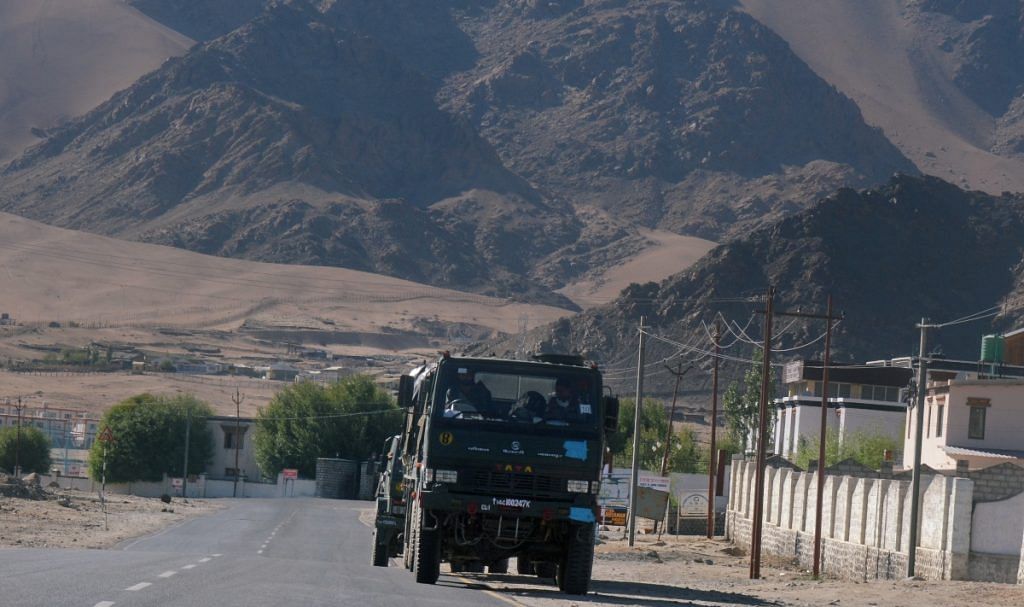New Delhi: The Army is grappling with creating adequate infrastructure, at short notice, for the 30,000 additional troops it has deployed at the Line of Actual Control (LAC) in Eastern Ladakh following the stand-off with Chinese forces.
With the stand-off still at a stalemate, despite multiple rounds of military talks at different levels, the soldiers will have to spend the winters on the icy heights of Eastern Ladakh.
Top defence sources, however, told ThePrint that sustaining the additional troops in the extreme winter continues to be a major cause of concern due to a military infrastructure deficit in the region.
This includes housing areas for the troops at the forward and relative depth areas; storage space, road space availability and spaces for housing specialised equipment.
A source said the situation in Ladakh is more challenging than even in Siachen — the highest battlefield in the world known for its inhospitable terrain — because the troops deployed in the glacier are fewer in number and the infrastructure for them has been created over a period of 30 years.
Both India and China have mobilised a large number of troops and equipment along the LAC in Ladakh in the last three months.
Also read: UAVs, high speed boats, All Terrain Vehicles — what Army’s Ladakh corps wants amid LAC row
The infrastructure shortage
The shortage of infrastructure stems from the fact that such large-scale movement of troops in Ladakh was unheard of in the past, the sources said.
“Moreover, one has to account for the fact that the rate of deterioration of infrastructure is faster there (in Eastern Ladakh) because of the extreme climatic conditions. Also, the deployment space is limited,” a defence source, privy to the challenges, told ThePrint.
A second source told ThePrint that given the heavy density of troops deployed there, there is a need to create living quarters, both closer to the LAC and also in the relative depths, where the acclimatised troops would be concentrated and kept ready for any subsequent deployment.
“The challenge also lies in deciding on the quantity of infrastructure that should be created now, which later may not be required if there is an actual de-escalation at the LAC,” the source said.
According to sources, the Army is looking at, as a temporary measure, converting some of the existing storage facilities into living quarters.
The sources also said that discussions are underway regarding how much of the specialised equipment can be kept under canvas during the winters, given their harsh nature and the fact that the existing buildings can barely cater to the routine stocking levels.
As reported by ThePrint, the Army is busy planning the logistics and winter stocking for the additional soldiers and procuring special winter clothing, arctic tents, aside from stocking of rations and kerosene oil, so that they can deal with the tough conditions expected during the six-month cold season.
“Construction of additional huts or bunkers along or closer to the LAC to cater for subsequent eventualities is also being deliberated on,” the first source quoted above said. “While there is no firing at the LAC, the need for bunkers cannot be ruled out in case of future eventualities.”
Another challenge is that the lay of the land, hard and rocky surface and narrow tracks hinder the movement of material and specialised equipment required for construction.
“The peculiarities of terrain entail select and limited deployment areas. While they are adequate for occupation of defences by small subunits, the challenge of creating administrative and training areas for a large unit of acclimatised troops is immense,” the source added.
Also read: Defence Ministry clears purchase of indigenous basic trainer aircraft, upgrade of Israeli UAVs
‘Limited working season biggest challenge’
A further challenge is ensuring water for the troops.
While there are a large number of rivers in the region, Army officers said ferrying the water from the source to the heights and the camping areas and its subsequent storage requires detailed planning and implementation.
“The limited resources exist and narrow roads confine the movement in one direction, thereby increasing the turnaround time,” the first source said.
The biggest challenge continues to be the limited working season ending in October, after which, no fresh work can start.
The second source said we need to realise that the number of troops has increased more than threefold and so, pressure on the existing infrastructure is intense.
“The entire population of Leh district is approximately 1.5 lakh people,” the source said. “An additional 30,000 troops is a 20 per cent increase. The challenge needs to be seen in the right perspective.”
Also read: 7 big-ticket ‘Make in India’ defence projects that have failed to get off the ground
